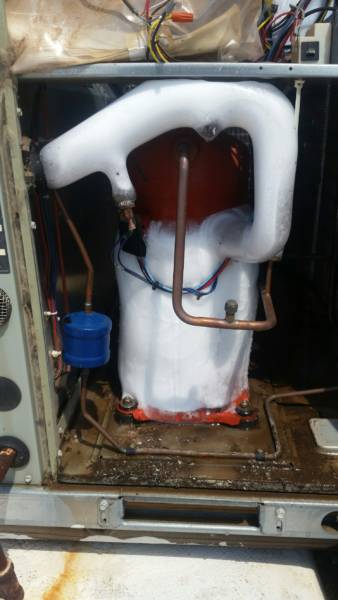My AC Pipe Is Frozen - What Do I Do? Guidance for Residents
My AC Pipe Is Frozen - What Do I Do? Guidance for Residents
Blog Article
Just about every person will have their own individual opinion on the subject of What Do I Do If My AC Pipe Is Frozen.

Intro
Finding that your air conditioner pipeline is iced up can be concerning, particularly during hot summer season when you depend on your air conditioning system the most. Recognizing what to do in such a scenario is crucial to prevent more damage to your cooling system and ensure your convenience indoors.
Understanding the Causes
Numerous variables can contribute to the cold of an a/c pipeline. Understanding these causes can help you deal with the issue effectively.
Absence of Airflow
One common root cause of a frozen AC pipeline is inadequate air flow. When the air movement over the evaporator coil is limited, it can create the coil to go down below freezing temperature level, bring about ice development on the pipeline.
Low Refrigerant Levels
Insufficient refrigerant degrees in your air conditioner system can also result in an icy pipeline. Low cooling agent levels can cause the stress in the system to go down, leading to the freezing of dampness on the evaporator coil.
Winter Conditions
In chillier environments, freezing temperatures outside can contribute to the freezing of air conditioner pipes. If your AC system is not properly shielded or if there are leaks in the ductwork, chilly air can infiltrate the system, triggering the pipeline to freeze.
Dirty Air Filters
Dirty or stopped up air filters can restrict air movement in your air conditioner system, bring about numerous concerns, consisting of a frozen pipeline. It's vital to change or clean your air filterings system regularly to make certain appropriate air flow and prevent ice accumulation.
Signs of a Frozen Air Conditioning Pipe
Acknowledging the indications of a frozen air conditioner pipe is essential for prompt activity.
Reduced Airflow
If you observe a significant reduction in airflow from your vents, it might show an icy pipe.
Ice Buildup on the Pipe
Visible ice buildup on the refrigerant line or the evaporator coil is a clear indicator of an icy air conditioner pipeline.
Unusual Sounds from the Unit
Uncommon noises, such as hissing or gurgling, originating from your a/c device can signify that there's ice existing on the pipeline.
Immediate Actions to Take
When confronted with a frozen AC pipeline, it's necessary to act quickly to prevent more damage to your cooling system.
Turning off the AC
The primary step is to shut off your air conditioner to stop the system from running and aggravating the problem.
Checking for Blockages
Inspect the location around the indoor device for any type of obstructions that may be obstructing airflow, such as furnishings or drapes.
Thawing the Pipe
You can utilize mild methods like positioning towels soaked in warm water around the icy pipe to assist thaw it gradually.
Preventive Measures
Taking preventive measures can aid avoid future incidents of an icy AC pipe.
When DIY Methods Fail
If your attempts to thaw the pipe or address other problems are not successful, it's time to contact a specialist.
Importance of Hiring a Professional HVAC Technician
A licensed HVAC service technician has the proficiency and tools needed to detect and fix concerns with your air conditioner system securely and successfully.
Routine Maintenance Checks
Arrange regular maintenance checks with an expert HVAC specialist to guarantee that your AC system is running successfully.
Altering Air Filters
Consistently change or clean your air filters to avoid air movement restrictions and preserve optimum efficiency.
Insulating Exposed Pipes
If your air conditioning pipelines are revealed to cool temperatures, consider protecting them to avoid freezing during winter season.
Looking For Professional Help
If DIY techniques stop working to solve the issue or if you're not sure regarding exactly how to proceed, it's best to look for aid from a certified HVAC service technician.
Final thought
Handling a frozen a/c pipe can be an aggravating experience, but recognizing exactly how to respond can aid lessen damages and bring back comfort to your home. By comprehending the causes, identifying the indicators, and taking timely activity, you can successfully address the concern and avoid future events.
Frozen AC Line: Why It Happens & What To Do About It
A frozen AC line can be a rather peculiar sight in a place like Phoenix, Arizona where nothing ever freezes. In this post, we’ll discuss what makes an air conditioner line frozen – and what you can do about it.
Dirty Air Filters
Did you know that you should be cleaning or replacing your air filters on a monthly basis? Failing to do this can result in airflow issues that, in turn, cause your evaporator coils and lines to freeze over. You’ll notice a buildup of ice on both components, although the buildup on your pipes will, of course, be more evident unless you open your air condition up to reveal the coils.
What To Do About It
Give your air filter a good cleaning if it’s reusable. If not, replace the filter outright. Next, switch your air conditioner’s fan setting on and leave it there for 2-3 hours. This will draw warm air in, helping to thaw your evaporator coil. You can also check out this article for some tips on cleaning the coils themselves if you’d like to speed the process up. Before you switch the unit back to its normal state, make sure the supply vents are completely unobstructed and free of dust or other debris.
If you keep having this issue even after replacing your filters regularly, contact a local HVAC repair company and have them inspect your evaporator coil, ductwork, and any other components that may be at fault. If you live in the Phoenix, Arizona area, give American Home Water and Air a call.
Low Refrigerant Levels/Leakage
What To Do About It
Contrary to what air conditioner “recharge” companies often tell their clients about refrigerant, it should never need to be simply refilled. You see, refrigerant runs in what experts refer to as a “closed loop.” Refrigerant really shouldn’t be leaving that loop. If it is, you’ve got a leak.
Paying someone to come and pump more refrigerant into your system (aka “recharge” it) isn’t the solution. Doing that will simply kick the can down the road. Besides, refrigerant leaks can be harmful to the environment and people in your home.
Rather, you need to take care of the leak with the help of a technician. Check out this article for some more information about dealing with air conditioners that are leaking refrigerant. Before you contact a technician, switch your thermostat to the off position. Then, switch the fan setting on and let it run for 2-3 hours so the unit can thaw.
Improper Temperature Setting
Improper temperature settings can also cause a drop in your air conditioner’s pressure. What many people don’t realize is that air conditioners are actually designed to run when temperatures have fallen above roughly 60 degrees Fahrenheit. If you run the unit when it’s cold outside, you’ll run into many issues, including frozen components.

I ran across that article on Why Is Ice On My Outside Air Conditione when doing research the search engines. Are you aware of somebody else who is serious about the subject? Why not promote it. Thank you for your time. Visit again soon.
Book Instantly Report this page